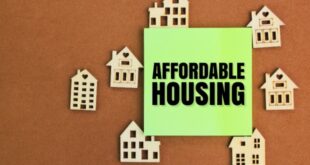Gov. Gavin Newsom is considering a bill that would place restrictions on the construction of warehouse-distribution facilities.
AB 98, which the Senate and Assembly passed Aug. 31, would establish strict regulations for the design and location of logistics facilities. It also would also establish guidelines for parking, truck loading bays, landscaping buffers, entrance-exit gates, and signs.
Newsom has until Sept. 30 to sign or veto the bill, which was introduced by Assemblywoman Eloise Gomez Reyes (D-San Bernardino) and, Assemblyman Juan Carillo (D-Palmdale). Its intent is to make life safer and easier for the people who live near logistics facilities, and who already have to put up with more traffic, noise and dirty air than most neighborhoods.
This is relevant to many people who live in Riverside and San Bernardino counties, which has so many warehouse-distribution projects – more than one billion square feet – that it has earned the moniker warehouse of the western United States.
“This is an issue that is felt acutely in the Inland Empire, where we are home to well over one billion square feet of warehousing, over 4,000 warehouses and approximately 600,000 truck trips a day.” Reyes said in a statement. “It establishes common sense standards and guardrails for warehouse construction in California.”
If it becomes law, AB 98 will put Sacramento in charge of something that has long been left to cities and counties, based on a project’s specific location and circumstances. That has generated some opposition to the bill.
“Warehouse-distribution centers are a local issue, but if AB 98 becomes law we will have to do everything the way the state tells us to,” said Fontana Mayor Acquanetta Warren, an opponent the bill. “There is no city or county input in this bill, and I don’t think that will work.”
AB 98 will go into effect Jan. 1, 2026 if Newsom signs it, at which point heavy-duty diesel trucks would be restricted near some “sensitive” sites, including residential areas, schools, parks, hospitals, and convalescent facilities.
A heavy-duty truck – sometimes called a straight truck – is one that weighs between 26,001 and 33,001 pound. Those trucks are generally used to haul industrial machinery, farming and military equipment and other extremely large items, according to heavyhauler.com, a website for people who drive heavy-duty vehicles.
AB 98 also requires that truck-loading bays be at least 500 feet from residential property lines, and that walls and landscaping be used as buffers between those two entities. Two new homes must be built for every one that is torn down to create space for a logistics operation, with the homes to be paid for by the project’s developer.
Also, any renter whose residence is removed to make room for a warehouse distribution project will receive the equivalent of 12 months rent, also to be paid by the developer.
Violations of AB 98 could result in a $50,000 fine every six months if the violations aren’t corrected.
AB 98 is aimed at reducing the environmental and health problems cause by logistics operations, but it will not make all of those problems go away, according to Gomez Reyes.
But it’s clear the logistics industry, particularly in Riverside and San Bernardino counties has caused enough environmental and health problems that some action must be taken now, Gomez Reyes said in a statement released one day after AB 98 was passed.
“I do not believe the setbacks in this bill go far enough to protect our most vulnerable communities,” Gomez Reyes said. “The distances outlined in this bill are only a minimum, and cities may adopt more stringent standards than what is outlined in AB 98.
“I urge cities and counties to expand on the standard set in this bill.”
At least one Inland city won’t be going along with that recommendation.
In a statement released Sept. 11, Victorville Mayor Liz Becerra called on Newsom to veto AB 98, which she called “an expensive, duplicate bill” that will curtail business development, not only in the High Desert but all of California.
“AB 98 severely limits our job creation efforts, leading our residents to drive one to two hours to find employment in the Inland Empire and LA area,” Becerra said in the statement. “Not only do these long commutes negatively impact the quality of life for our residents and their families, but long commutes also increase vehicle miles traveled and harm air quality.”
AB 98 is a potential threat to the Inland economy, according to a report by the California Center For Jobs and the Economy, a non-profit that advocates for jobs and economic growth.
AB 98 “would add further regulations and restrictions to the state’s warehousing sector,” the report states. “Warehouse shortages, along with other trade channel bottlenecks, led to vessels backing up at the state’s ports during the recent pandemic. These bottlenecks led to shortages, and consequently rising price, for both consumer goods and critical parts and materials for production throughout the United States.”
The report maintains that AB 98 would add to the state’s heavy-handed regulatory environment, which then reported claims has weakened California’s regulatory environment for nearly 20 years.
Since 2006, the Southern California ports – Long Beach, Los Angeles, Hueneme and San Diego – and their supply chains have lost lost 23 percent of their market share to other states, according to the report.
As a result, Southern California has lost approximately 45,500 jobs annually since then, as well as $3.8 billion in labor income, more than $590 million in state and local tax revenue and about $44 billion to the Southern California economy.
“Curtailing new warehouse space statewide through higher regulatory compliance costs means jobs will be at risk of moving to other states,” according to the report.
 IE Business Daily Business news for the Inland Empire.
IE Business Daily Business news for the Inland Empire.


